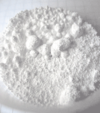Barium sulfate
 |
|||
|
|
|||
| Identifiers | |||
|---|---|---|---|
|
7727-43-7 |
|||
| 3D model (Jmol) | Interactive image | ||
| ChEBI |
CHEBI:133326 |
||
| ChEMBL |
ChEMBL2105897 |
||
| ChemSpider |
22823 |
||
| ECHA InfoCard | 100.028.896 | ||
| EC Number | 231-784-4 | ||
| PubChem | 24414 | ||
| RTECS number | CR060000 | ||
| UNII |
25BB7EKE2E |
||
|
|||
|
|||
| Properties | |||
| BaSO4 | |||
| Molar mass | 233.38 g/mol | ||
| Appearance | white crystalline | ||
| Odor | odorless | ||
| Density | 4.49 g/cm3 | ||
| Melting point | 1,580 °C (2,880 °F; 1,850 K) | ||
| Boiling point | 1,600 °C (2,910 °F; 1,870 K) (decomposes) | ||
| 0.0002448 g/100 mL (20 °C) 0.000285 g/100 mL (30 °C) |
|||
|
Solubility product (Ksp)
|
1.0842 × 10−10 (25 °C) | ||
| Solubility | insoluble in alcohol, soluble in concentrated, hot sulfuric acid | ||
| -71.3·10−6 cm3/mol | |||
|
Refractive index (nD)
|
1.636 (alpha) | ||
| Structure | |||
| orthorhombic | |||
| Thermochemistry | |||
|
Std molar
entropy (S |
132 J·mol−1·K−1 | ||
|
Std enthalpy of
formation (ΔfH |
−1465 kJ·mol−1 | ||
| Pharmacology | |||
| V08BA01 (WHO) | |||
| by mouth, rectal | |||
| Pharmacokinetics: | |||
| negligible by mouth | |||
| rectal | |||
| Legal status |
|
||
| Hazards | |||
|
EU classification (DSD)
|
not listed | ||
| NFPA 704 | |||
| Flash point | noncombustible | ||
| US health exposure limits (NIOSH): | |||
|
PEL (Permissible)
|
TWA 15 mg/m3 (total) TWA 5 mg/m3 (resp) | ||
|
REL (Recommended)
|
TWA 10 mg/m3 (total) TWA 5 mg/m3 (resp) | ||
|
IDLH (Immediate danger)
|
N.D. | ||
|
Except where otherwise noted, data are given for materials in their standard state (at 25 °C [77 °F], 100 kPa).
|
|||
|
|
|||
| Infobox references | |||
Barium sulfate (or sulphate) is the inorganic compound with the chemical formula BaSO4. It is a white crystalline solid that is odorless and insoluble in water. It occurs as the mineral barite, which is the main commercial source of barium and materials prepared from it. The white opaque appearance and its high density are exploited in its main applications.
About 80% of the world's barium sulfate production, mostly purified mineral, is consumed as a component of oil well drilling fluid. It increases the density of the fluid, increasing the hydrostatic pressure in the well and reducing the chance of a blowout.
Barium sulfate in suspension is frequently used medically as a radiocontrast agent for X-ray imaging and other diagnostic procedures. It is most often used in imaging of the GI tract during what is colloquially known as a "barium meal". It is administered orally, or by enema, as a suspension of fine particles in a thick milk like solution (often with sweetening and flavoring agents added). Although barium is a heavy metal, and its water-soluble compounds are often highly toxic, the low solubility of barium sulfate protects the patient from absorbing harmful amounts of the metal. Barium sulfate is also readily removed from the body, unlike Thorotrast, which it replaced. Due to the relatively high atomic number (Z = 56) of barium, its compounds absorb X-rays more strongly than compounds derived from lighter nuclei.
The majority of synthetic barium sulfate is used as a component of white pigment for paints. In oil paint, barium sulfate is almost transparent, and is used as a filler or to modify consistency. One major manufacturer of artists' oil paint sells "permanent white" that contains a mixture of titanium white pigment (TiO2) and barium sulfate. The combination of barium sulfate and zinc sulfide (ZnS) is the inorganic pigment called lithopone. In photography it is used as a coating for certain photographic papers.
...
Wikipedia



